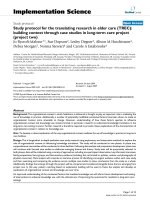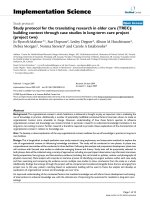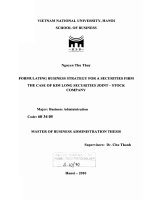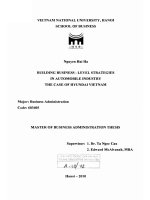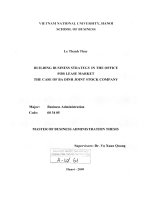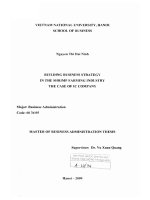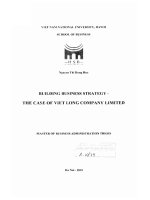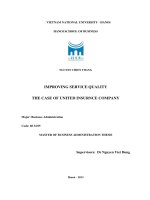Building business strategy-the case of Viet Long Company limited
Bạn đang xem bản rút gọn của tài liệu. Xem và tải ngay bản đầy đủ của tài liệu tại đây (8.49 MB, 110 trang )
VIET NAM NATIONAL UNIVERS1TY, HANOỈ
SCHOOL OF BUSINESS
— H s B —
I ĩ f\ n I - f •
Nguycn Thi Hong Hue
BUILDING BUSINESS STRATEGY -
THE CASK OF VIET LONG COMPANY LIMITED
M AS I i:li OK BUSINKSS ADMINISTRATION IHKSIS
A -1 0 / 3 5
Ha Noi -2010
TABLE OF CONTKNT
AC K NO WL K DGE M ENTS i i i
ABSTRACT iv
I ỎM TẤT vi
TABLE OF CONTKNT vii
LIST OF CHART, TABLE AND KIGUKK
xi
INTKODUCTION xiv
1 Problcm statcmcnt
xiv
2 Ai 111 and obịcctivcs xiv
3 Scopc of work XV
4 M cthodology XV
5 Research qucstions
XV
6 Data collccũon XV
7 Signiíícance xvi
8 Lim italion xvi
9 Kindings xvi
10 Thcsis structurc
xvi
CHAPTKR I: THEOKKTICAI. FOUNDATION 1
1.1 Building husinesscs strategy to cnterprise
1
1.1.1 An ovcrvicvv of slrategic managcincnt ]
1.1.2 Role of stratcgic management to entcrpriscs 2
1.1.3 Business stratcgy altcmalives
4
]. 1.4 Process lo builđ busincss slrategy to cnterprise
6
1.1.5 Applied modcls to builđ business strategy to cnlerprise
9
1.1.5.1 PEST Modcl 9
1.1.5.2 Five Korcos Models
10
viii
1.1.5.3 Value Chain 13
1.1.5.4 SWOT Modcl
15
Kcmarkable points in huildin” busincss stratcgy for Vict
1.2
Long Coinpany Limited 17
1.2.1 Characteristics of enterpriscs in Vict Nam bicyclc industry
1.2.2 Fragrnentation oCthe bicyclc industry 18
1.2.3 Transilion to maturity ofV iel Nam bicycle industry
21
1.2.4 Slratcgic group in Viet Nam bicycle industry
23
1.2.5 Entry into nevv business through inlcrnal developnicnt
25
CHAPTKR 2: EXTERNAL AND INTKRNAL ANALYS1S 26
2.1 Ovcrvicw of Viel Nam bicyclc induslry
26
2.2 Extcmal analysis 29
2.2.1 Environmcntal scanning and (orccasting - Pest analysis
29
2.2.1.1 Polilical Taclors
29
2.2.1.2 Economic íactors 34
2.2.1.3 Social Taclors 38
2.2.1.4 Technology lactors 42
2.2.1.5 PKST conclusion 45
2.2.2 Industry analysis l;ivc Forces Model 45
2.3 Intcmal analysis
57
2.3.1 Ovcrvicvv o f Vict Long Company
57
2.3.2 Valuc Chain analysis 59
2.3.2.1 Primary activitics 29
2.3.2.2 Supporting activilies 65
ix
CHAPTER3: STRATECỈY KORMl I.ATION AND 69
IMPLEMENTATION
Estimation oí dcmand and supply íbr Viet Nam bicycle
3.1 69
industrv
3.2 SWOT analvsis 73
Pormulation oi'strategy tbr Vict Long Company
3.3 79
Limited
Implicalions for business stratcgy for Vict Long Company
Limited
3.5 Stratcgy implcmentation
85
3.5. ỉ Implemcntation of dilTerentiation by branding strategy
87
Implemenlation of diíĩerentiation by customer services
3.5.2 89
slratcgy
3.5.3 Supplicr nctvvork building slrategy implcmenlation
91
Invcstmcnt on research and development stratcgy
3.5.4 . 93
implcmcnlalion
Investinent on machinc and equipmcnt stralegy
5.2.5 94
implemcntalion
CONCLUSIONS
Rclcreiìccs
Appendix A: Importcd tax ralc to bike and components
Appendix B: List of intcrvicvvccs
X
LIST OF FIGURE
Kigurel.l: Strategic management process 2
Figurcl.2: Typical business stratcgies 4
Figure 1.3: Strategy íbnnulation process 7
Kigure 1.4: Relationship between environmental, competitive and internal
8
organizational analysis
Pigure 1.5: PEST Modeỉ 9
Pigure 1.6: Five forces Modcl 11
Pigure 1.7: Value Chain 14
Pigure 1.8: SWOT Matrix 16
Figure 2.1: Viet Nam bicycle industry Iifecycle 26
Pigure 2.2: Highlight of Viet Nam bicycle industry 28
Figurc 2.3: Strategic group in Vict Nam bicycle industry 47
Pigure 2.4: Viet Long bike production process 60
Figure2.5: Organi/ation structure of Viel Long Company 66
F-'igurc 3.1: Custoincr group analysis 84
xi
Tablc 2.2: Impact ofPEST íactors on Viet Nam hicycle industry 44
Table 2.3: The numbcr of bicycle manuĩactured and assembled enterprises 45
Table 2.4: Strategic group vvithin Viet Nam bicyclc industry 46
Table 2.5: Product category of industry main players 50
Table 2.6: Comparison oTlransport modes’ bcncfits 53
Table 2.7: Five forces assessment 56
Tablc 2.8: Time consume of bikc assembling proccsscs 61
Tablc 3.1: Estimatcd demand on bicycle in 2009-2014 69
Table 3.2: Opportunities and threats ofViet Long Company 73
Table 3.3: Competitive strength assessmenl for Vict Long Co. Ltd 74
Table 3.4: Strenglh and weaknesses ofViel Long Company 77
Table 3.5: SWOT Model ofViet Long Company Limited 78
Table 3.6: Advantage and disadvantage analysis for cach busincss strategy
as in thc casc of Viet Long
Table 3.7: Kunction stralcgies for Viet Long Company 85
Tablc 3.8: Customer Service activities of industry main players 90
LIST OF TABLE
Table 2.1: Avcrage bike per person by agc group 39
xii
Chart 2.2: GDP of Vict Nam 34
Chart 2.3: Daily demand of transportation in Vicl Nam 35
Chart 2.4: Daily detnand of transportation in 1 la Noi 36
Chart 2.5: Daily demand of transportation in I lo Chi Minh City 36
Chart 2.6: Viet Nam population and ĩorecast 38
Chart 2.7: Population aging structure and íorecast 39
Chart 2.8: Sale breakdown of Viet Long Company Limited in 2008 57
Chart 3.1: Estimation of dcmand for Viet Nam bicycle industry (2009-
2014)
Chart 3.2: Projection of dcmand for bicyclc by scgments, 2014 70
Chart 3.3: Segments in Viet Nam bicyclc industry (2008 and 2014) 71
Chart 3.4: Markct share of Vict Nam bicycle industry by segments, 2008 72
LIST OF CIIARTS
Chart 2.1: Export value of Viet Nam bicycle industry 32
xiii
INTRODUCTION
This chaptcr indicates an introduction of thc research. First problem setting will
be provided, followed by aim, objectives and scope of work. After that,
methodology that is applied in the rcsearch is prcscnted. It is followed by
research questions, data collection, signiíìcance and limitation, and íìndings of
the research. Final1y thesis structure will be presentcd in orđer to give readers an
ovcrall picture of thc paper.
ỉ. Problem statemcnt
Viet Long Company Limited (Viet Long Co. Ltd) is a private-ovvncd entcrprise
which manufacturcs bike parts, including axlc-tree, pcdal and tnayor. The
company has just dcvcloped a nevv product, which is bicycle, since 2008. It’s
necessary to build busincss strategy for Viet Long Company to find the way of
surviving and growing in Vicl Nam bicycle industry.
2. Aims and objectives
The aim o f the thesis is lo build an appropriate busincss slrategy for Viet Long
Co. Ltd, íocusing just only one new product thai is bicyclc in the next five years,
from 2010 to 2014.
The objectives o f thc thesis are as belovv:
s Firstly, providing bctter understanding of thcorctical íbundation in
building business slrategy for enterprises.
s Secondly, applying theorics into Viet Long Company to fígure ouí thc
company opportunities, threats, strengths and wcaknesses. Then Viet
Long business stratcgy are built, íbcusing on product of bicycle.
s Thirdly, drawing out overall implications for strategy implementation in
Vict Long Co. Ltd
xiv
3. Scope of \vork
The study íbcuses only on Vict Long Co. Ltd, Hnding thc company’s business
contexl, opportunities, threats, strengths and vveaknesses. Business strategy for
Vict Long Company in the Corning fíve ycars, from 2010 to 2014, vvill be
íbrmulatcd, focusing on bicyclc. Finally, the research draws out implications for
stratcgy implementation in Vict Long Co., Ltd.
4. Methodology
The sludy íocuses on only Viet Long Co., Ltd, investigate a contcmporary
phenomenon within its real-life context and usc multiple sources of information.
Thcrclore, case study is choscn as research methodology to makc an in-dcpth
investigation.
5. Research questions
In order to reach aim and objectives, thcsc rescarch questions have been
developcd:
/ What is the way lo huild business stralegy for enterprise?
s What is appropriale business strategy for Viet Long’s bicycle?
S How to implemcnl the strategy?
6. Data collcctiou
Duc to rcscarch topic, aim and qucstions, data is collccted via sourccs of
documcntation, archival rccord and intcrview. Documcntation and archival
record obtaincd from public papers, company profilc and annual reports of
relcvant parties supporting analysis of cxtemal and internal organizational
environment.
Opcn-endcd interviews are conducted directly with industry experts, Vict
Long’s director and employees. In some cascs, interview is considered as
signiíìcant iníbrmation sourcc due to limitalion of availablc data.
XV
7. Signiĩicancc
The rcscarch contributes signiíìcantiy to the economy and the enterprise:
To the economy: The study provides bctter undcrstanding of building business
strategy framework for cntcrprises in Viet Nam bicycle industry. In addition, the
stuđy can be a refercnce to fírm s in other Industries.
To the enterprise: The study finds out business context, opportunities, thrcats,
strengths, vveaknesses and appropriate business strategy for Viet Long’s bicyclc.
In addilion, the rcscarch proviđes implications for stratcgy implementation in
Viet Long Company.
8. Limitation
The study íocusesjust only on Viel Long Company. Conscqucntly, íìndings of
thc rcsearch can not bc applied for other íìrms, but can be good reference to
other ones in the same industry.
In addilion, available data of mechanics industry, bicyclc industry and íoreign
competitors is iimitcd. ỉn some cases the author collects information froin most
rclevant sources as cxpcrt ideas to solve thc issuc.
Due to íragmentation of the bicycle industry, indưstry analysis will focus only
on main playcrs who covcr noticeable market share.
9. Findings
The study finds out appropriate busincss and íunctional strategies lbr Viet Long
Company. In addition, the study intends to draw out implications for strategy
implementation in Viet Long Company.
10. Thesis structure
Due to topic and research methodology, the thesis is divided into threc main
chapters: theorctical íbundation, extemal and intcrnal analysis, and strategy
íbrrnulation and strategy implementation íor Viet Long Co. Ltd. In addition,
xvi
research introduction and conclusion arc prcscntcd at thc beginning and the cnd
of the papcr.
The íĩrst chapter, thcorctical íoundation, indicates theories that have been
applied to analyze and build business and íunctional strategies for Viet Long Co.
Ltd.
Extemal and internal analysis via models of PEST, five forccs, SWOT and value
chain are indicates in thc second chapter of thc thesis.
And íìnally, thc formulation and choice of busincss and íunctional strategies for
Vict Long bicyclc is presented at thc third chapter. Moreovcr, implications to
strategy implcmentation for Viet Long Company are dravvn out.
The figurc below visuali/.cs the main chaptcrs of thesis:
Introdaítion
Tlttorctical
rovadatlon
ExttrMlasd
Xo»»nwl âMtyih
StrategỴ
ío rm aU tìo n
aod
CondusiOB
xvii
C H A PT ER
1: THEORETICAL KOUNDATION
In this chapter, available theories relevant to solve research questions are
prescnted. Pirstly, deíìnitions related to strategy managemcnt, role of business
strategy to enterprises and strategy altematives are indicated. It is followed by
applied models and process to build business stratcgy for enterprises. Finally,
the research indicates some remarkable points in building business strategy for
Viet Long Company Limited.
1.1. Buiiding busỉncss strategy
1.1.1. An overview of strategic management
Stratcgy describcs the way enterprise shoulđ follow in ordcr to reach its goals
undcr consideration of cxternal and intemal environment. Slratcgic management
is the process by which top managemcnt determines the long-run direction and
pcrformance o f the organization by ensuring that careful íormulation, effective
implementation and continuous cvaluation of stratcgy takes place (Lloyud Byars
at et., 1996).
Stratcgic management can be broken down into three phases: strategy
ibrmulalion, strategy implemcntation and strategy evaluation. Strategy
iormulation involvcs in analyzing extemal and intcrnal environment; dcíìning
the organization’s guiding Vision, mission and objective; and selecting
appropriate strategy. Strategy implementation is conccrned with making
dccisions with regard to organizational structure, leadcrship and motivational
systems that is suitable to chosen strategy; establishing short-range objcctives,
developing budgets and íunctional stratcgics to support chosen strategy. Stratcgy
evaluation involvcs in activilies of establishing standards of performance for the
organization and its units or ĩunctional areas; assessing and measuring the
implementaíion of strategy; initiating right actions to ensure continued
1
commitment to thc implcmcntation of strategy(Lloyud Byars at et., 1996). The
following Hgurc visualizcs strategic management proccss.
Pigurc 1.1: Strategic managcment process
Stratogy
Stratcg}' Stratcp
íonnulalỉoit im p lm ta tio n
evaliiâtion
Source: Adcipteđ from Lìoyd L. Byars, Leslie w. Rue, and Shaker A. Zahra,
Strơtegìc Management, ỉrvvin Press USA, 1996.
Strategy exists at different lcvcl in an organization base on the scope that the
firm accomplishes. In gencral, strategy is considcrcd at corporate, business and
íunctional lcvels. Sírategies lliat address what businesses a multiplc-business-
unit organization will be in and how rcsourccs will bc allocated among those
businesses are referrcđ to as corporatc stratcgy (Lloyud Byars at ct., 1996).
Business strategics focus on how to compete in a given business (Lloyud Byars
at et., 1996). Functional stratcgies deal with how to iinprove or combine
organizational rcsourccs, such as prođuction, ílnance, personnel, etc in order to
gain compctitive advantagcs.
1.1.2. Rolc of stratcgic managcmcnt to enterprises
Strategic management is necessary and valuable to not only largc but also small
organization. Many empirical studics have bccn done in order to evaluate the
relationship betxveen strategic management and the períormance of
organizations. For cxample, Robinson (1982) found that small businesses that
employed consultant to hclp with strategic planning lcnded to pcríorm better
2
than íìrms lliat did not (Karhad, 2003). Several othcr studies have reportcd
positivc rclationships between íormal stratcgic planning and íìnancial
performancc in small ílrms (Jones, 1982; Ackclsberg and Arlow, 1985; Sexton
and Van Auken, 1985 ).
Strategic management has critical impact on cxistcnce and performance of
enterprises. Slrategic planning provides enlerprises necessary direction. Without
Vision, mission, goal and objectives, companies do not know the point it has to
reach and like to bc someone lost in matrix. It is morc important to SMEs with
limited resourccs to get in the right way.
It is clearly thai thc bencíìt helps eliminate weakncsscs of many enterprises’
managers of lacking visionary thinking. Strategic planning helps top managers
know wherc to go, what way to go and how to go. From that, Vision, mission,
goais, objectives, corporatc value, strategies and action plan was crcated. Aíter
that, thcsc ideas will bc sprcad to whole entity. Conscqucntly, all organizational
units will work tovvarđ thc same objectives and purposes. Without the direction
provided by strategic managemcnt, individual units can go in different ways.
Another bencfit o f strategic management to enterprises is rcsults of the process
itseir but is not produced Products by the process. Thcse bcneíìts rise in the
effort of engaging strategic managcmcnt such as action plan or strategy
cvaluation system those might bc produced by thc process.
The strategic management process also force managers lo be more proactive and
knowledgeable about extcmal and intemal environment. In addition, enterprises’
inanagers will gain the habit o f thinking in terms of the future, which most of
SMEs managers arc lacking of because they usually sunk into daily operation.
One of the major benefits of stratcgic managcment is Ihc opportunity to involve
in the process of diíTerent management levels within enterprise. Strategic
management process gives a chance to lower level o f managers participating in
the process o f making decision. Conscquently, they will bc more understandable
3
about situation thc firm stuck into, limitcd factors and possiblc altcmatives.
Thereíore, resistancc from thcsc ones might reducc. The cnterprises will reach a
consensus.
1.1.3. Typical business strategies
There are three generic strategies to outperibrm other firms in an industry:
overall cost lcadership, differentiation and íbcus.
Overall cost ỉeadership
An ovcrall cost lcadcrship strategy involvcs producing and dclivering the
producl or Service at a lovvcr cost than compctitors (Lloiy Byars et al., 1996).
Cost leadership stratcgy is attractive because it crcatcs íìrm’s competitive
advantage to compctitors by low price, prolcct firm from potcntial ncw entrants.
In somc case, thc stratcgy also helps fírm avoid shaving pricc prcssurc of buyers.
Figure 1.2: Typical business sirategies
ITniquent*$ perceived
by customers
Low cost positlon
Industry
wide
Parttcular
segment
©5
o
H
0
ú
Source: Adapted Farhad Analoui and Azhdar Karami,
Sírategic Management in Smaỉỉ and Medium Enterprises, Thomson, 2003
4
In ordcr to implement successĩully cost leadership síratcgy, the enterprise has to
pursue cost rcduction from cxperience, marginal customers, overhead and cost
minimization in sale, research and dcvelopmcnt, advertising and Service. In
addition, the firm has to achieve a high markct share, favorable asscss to
material, well designing products for ease in manufacturing or maintaining a
vvide relatcd-product rangc to spread costs.
As pursuing cost leađership strategy, the firm may coníront to risks of
tcchnological changes thai make past investmcnt and leaming worthlcss.
Another risk is low cost achicving by others such as ncw comers or followers
via imitation or statc-of-art facilities investmcnt. In some cases, the firm ihat
locuses much on cost might bc blind in changcs inside and outsidc industry,
such as tnarketing, product requirements, customer taste, etc. Inflation may bc
the ilnal risk. This cconomic phenomenon can inakc thc price đistance betvvccn
the fìrm and competitors eliminate or narrow down.
Diffcrentiation
A dií‘fercntiation stratcgy requires that an organization crcate a product or
Service that is recognÌ7.ed industry-widc as being unique, thus pennitting íhc
organization to charge higher-than-average prices (Lloiy Byars et al., 1996).
Therc exist many approaches to takc differentiation, such as dcsign or brand
name, technology, ĩcatures, customer Service, dcaler netvvork or othcrs. The core
of the concept is achicving competitive advantagcs via brand loyalty of
customers who has lower price sensitivity.
The strategy givcs íìrrn compctitive advantage due to different Products or
services. In addition, the company can charge higher pricc, lcading to highcr
proHtability. DiíTerent Products also bring íìrm an incrcasing bargaining power
to buyers because of lacking comparable altematives. Ít mak.es higher mobility
barricrs as a result o f customer loyalty and producl uniqueness. The strategy
requires strong marketing abilities, product enginccring, Creative flair, strong
5
capacity in research, strong cooperation 1'rom channel, etc to crcatc sole Products
and gain brand idcntiíìcation of customcrs.
As conducting differentiation strategy, thc firm may face series of risks. There
exist a large pricc distance betvveen low-cost and diíTcrentiate Products, so that
customers vvill become Icss willingness to pay for additional Service, features,
image o f differentiated firms for large saving cost. As customers becomc
sophisticated, thcir nccd for differentiation reduces. Another risk can be
imitation and fake products rcducing customers’ avvarc of differentiation, niostly
in maturity industry.
Focus
A focus strategy involves targeting a particular buycr group, a geographic
market segmcnt or a ccrtain part of the product line and serving this well-defined
but narrow markct better than competitors who serve a broadcr market (Lloiy
Byars et al., 1996). Focus strategy takes many forms: locus cost leadership,
focus differentiation or both. It meatis that the company can achieve
diffcrentiation or/ and lowcr cost to better scrvc a particular target. Focus
strategy involves in anothcr sct of risks. The lcvel of diffcrentiation betwecn
products or Services of thc who!e market and Pocus one is narrow down by timc.
Another risk, compctitors can íìnd out submarkets in targct market make the
focuser to bc out-focused.
1.1.4. Process to build business strategy to cntcrprisc
Building business strategy is the most important phrase in stratcgic managcment
process. The process includcs three main stcps. Firstly, cnterprise philosophy,
purpose and mission arc dcíìned. After that, the stagc of objectives setting is
conducted via extcmal, intcmal and SWOT analysis. Finally it is the process of
strategy selection. The iìgurc below visualizcs the process of building business
stratcgy to entcrprise in ordcr to draw out clearer picturc about this topic.
6
Step I: Defming the guiding philosophy, purpose and the mission o/enterprise
An organi?;ation’s guiding philosophy indicates Ihe values and belicfs of the
organization. It points out what is important in life and business, how business
should be conducted, thc vievv of humanity and organization’s role in society.
Organizational purpose dcílnes the íunđamental rcasons for the organization’s
existence (Collin and Porras). Ít can be expressed in a clcar statemcnt of how the
company niỉs human necd or how the business impacts thc world.
Organizational mission is an overall goal of the organization that provides a
sense of dircction and a guidc to dccision making for all lcvcls of managcmcnt
(Lloyd L. Byars ct al., 1996).
Figure 1.3: Stratcgy formulation process
Vhion d*fyf»g prow$
ObJwttví proms
Strotígy tHKílni
Dtĩming lhf
ratuloD
ỈBriroBnmital
íoróMting
pmmlỳiis
Comprtiliư
nnilvsH
fheF»rrn
ffl0<)d
lodcoUíyỈBỉ
Slrelqịv
SllHlP^lC
ĩonmilílion
#llau»Uvw au<) sdcrtioo
Source: Adapted from LìoydL. Bvars, Lesỉìe w. Rue, and Shaker A. Zahra,
Strategic Management, ỉnvin Press, USA, ì 996
1
The stcp of objective setting combines thrce major sub-stcps: extcrnal analysis
(cnvironmcntal scanning and forecasting, and compctitive analysis within
industry), internal organizational analysis and long-range objectives
establishing. The cxternal analysis identiíícs enterprise opportunities and threats.
The cxtcmal analysis is conđuctcd via Five Porces, Industry Life Cyclc, Value
Chain and PEST (political, cconomic, social and technological ĩactors) models.
Then SWOT analysis is donc in order to draw out conclusion about the
enterprise current situation and thc need for stratcgic action. Finally, long-range
objcctives which speciĩy the results desircd in pursuing Ihc enterprise’s mission
is cstablishcd. Long - rangc objcctives directly are impactcd by SWOT analysis,
because these objcctivcs should help the organization catch opportunities,
exploit strengths, minimize Ihrcats and eliminate weaknesscs.
Figure 1.4: Relationship between environmental, competitive, and intemal
organi/ational analysis
Step 2: Obịective setting process
Source: Lloyd L. Byars, Lesỉie
w.
Rue, and Shaker
A. Zahra, Sírategic Management, Irwin Press, USA, 1996
8
There are many distinct strategies at corporate, business and functional levels
that an cnterprise can choose to follow. The managers can find out thc most
appropriate strategies after deíĩning clearly the guiding philosophy, Vision and
the mission o f organization; compleling organizational extcrnal and intemal
analysis and setting objectives. The most appropriate strategy has to basc on
speciíìc situation of the firm. The organizational strategy may change from timc
to time.
1.1.5. Applied models to built business strategy to enterprisc
1.1.5.1. PEST Model
PEST Model is a widely used framework in organizationaỉ cxtemal analysis,
1'ocusing on macro environment. The model analyzes íour main factors:
Step 3: Sírategy seỉection process
Figurc 1.5: PEST Modcl
Source: Lloyd L. Bvars, Lesỉie w. Rite, and Shaker
A. Zahra, Strategic Management, lrwin Press, USA, 1996
9
p - Political factor, including impact of elected off1cials, govemment ]aws and
special interest groups on organizations (Lloyd L. Byars et al., 1996) such as
labor law, rules on taxation, trade, advertising, or imporl-export regulations.
E - Economic factor, including fluctuation of local, national and global
economies such as inflation, growth rate, interest rate, taxation, trade, exchange
rate, or CPI.
s - Social factor, relating to the values, attitudes and dcmographic
characteristics of the enterprise’s customers.
T - Tcchnological Taclor, including not only invention of new product and
technology but also improvement in method, Processing, design, materials and
application in orđcr to makc work more efficicncy, etc
All thesc factors do not directly control but affcct much on the industry and
organizations thai opcratc in the industry. PEST analysis is conducted through
three sleps. Firstly, scope of analysis for each factor will be bounded by
geographical scale oỉ' organizational operation. Seeondary, scanning and
tbrecasting are donc in ordcr to obtain relevant iníbrmation, focusing on current
events and rcasonablc assessment of future trcnds. Pinally, information is
packed inlo forms that arc useful for strategic planning.
1.1.5.2. Five forces model
Five forces modcl dcveloped by Michael Portcr is vvidcly used in industry
analysis. Porter’s fivc forces includes: bargaining power of suppliers, bargaining
power of'buyers, threats of new entrants, threat of subslitutes and rivalry among
compctitors. The modcl helps managers gain insight into competitive dynamics
of induslry, undcrstand how each force influence to company proíìtability and
períbrmance, and providc thc company what is the way to counter the strength
of these forces. All thesc factors together dctermine profit potential of an
industry via iníluencing prices, costs and requircd invcstmcnt of businesses.
10
Bargainingpower ọ/ suppliers
Supplicrs havc most povver whcn (Lloyd et al 1996):
(!) Few suppliers are availablc. (2) requircd inputs are unique making it costly
to switch suppliers, (3) thc input of the company purchases do not represcnt a
signiíìcant of the business of thc suppliers, (4) thcre are very few substitute
products, (5) suppliers can integrate forward, (6) suppliers can sell directly to
customers by passing thc nccd for the company business, (7) it is difficull to
switch to another supplier, (8) and the company do not have a full understanding
of markct of its supplicr.
Figurc 1.6: Five íorces Model
T h rr a ls o r nr\v
cn íra IIỈS
D argaln lng
Com pctlitvc
B argclnlng
p o w e ro f rtv alry 'Vlttiln
p o tv c ro í
n up p lte n an tn đustry
cu sto m r n
T h rea ts
O T
tn b itltu tc
P r o d u c t s
Source: Lìoyd L. Byars, Leslie w. Rue, and Shaker
A. Zahra, Strategic Management, Irwin Press, USA, 1996
In ordcr to rcducc povver of suppliers, the company might consider íorming a
partncrship with supplicrs, such as reduce inventory cost by providing just-in-
time đeliveries, infonn to suppliers information about custoincr nccds and
prcferences or spced the adoption of new technologies. Another option to
increase the company powcr is íbrming a buying group of small producers. The
company can choose to inlcgrate back and produce its own inputs by purchasing
one supplier.
11
Bơrgaining power tìf 'buyers
Buyers have more power vvhen: (1) buyers are few and they buy in large
volumcs relative lo industry salcs, (2) products rcpresent a relatively large
cxpense for customers, (3) the product is not uniquc and, thereíore, easily
substitutable, (4) customcrs can intcgrate backvvard and product its themselves,
(5) customers can easily svvitch to another prođuct vvith little cost, (6) and
finally, customers have much market iníbrination.
In order to reduce bargaining power of customcrs, thc company can increase
their loyalty by partnerships or loyalty programs, selling directly to customers,
adding features or branding to incrcase pcrceived value of product.
Threat o f new entrants
Threat of new entrants is thc possibility the new íìrm with dcsire to gain market
share will cnter the industry. Analyzing threal of new cntrants relatively
considcr barriers to entry and respond of cxisting íìrms lo a new comer. Entry
barriers can hc tangible and intangible. Tangiblc rcquirements are Capital,
lechnology, know- how, ctc. Intangible requirements are reputation of cxisting
íìrms, brands, customer loyally to current produccrs, customer switching cost.
The threat of ncw cntrant is grcatest when: (1) processes arc not protected by
rcgulations or patents, (2) brand loyalty of customcrs is little, (3) low start-up
cost, (4) low switching cost, (5) production proccss is lcarned easily, (6) inputs
and customcrs can hc accessed casily, (8) economies of scale are minimal. Entry
barriers also arc affcctcd by respond of existing firm to ncw company. Existing
companies can rcduce price, conduct new markcting plan, introduce new
product to make the market more compctitive. In order to rcduce threat of new
entrants, company can popularize image, utilizing patcnts, creating alliances
with associate Products. Managcrs should also considcr barricrs to cxit, such as
company’s physical assets, facilities, effect of industry, local community, etc.
12
Both cntry and exit barriers also influence on compctitivcness in the industry
and preventing new comers to jump inlo the industry.
Threaí o f substitutes
Substitutes are Products served the same purpose and needs of customers. The
thrcat of substitutes appears as alternatives product have lower price or better
períbrmance or both. Substitules can reduce demand for your product and create
pressure for lower price. Substitutes are greater threat as: (1) your product do not
have any real beneíìt in comparison to other Products, (2) the product is easily to
svvitch, (3) high customer elasticity by price. The company can reduce threat of
substitutes by satisfy customers prcferences and đifferentiating company’s
product by branding.
Rivalry among competitors
Rivalry among competitors is most intense vvhen: (1) there are numerous
companies, (2) companies arc similar to each other in size, (3) companies are
difFerent in national culturcs, goal, or origin, (4) industry growth ratc is low, (5)
one fírm or some firms would like ío be markel leader, (5) high fixed costs of
production prcssure companies to produce near capacity, (6) Products arc
pcrishablc and need to be sold quickly, (7) products are not unique , (8)
customers can easily to switch bctvveen product. In order to reduce rivalry
among compctitors vvithin industry, the company can invest in research and
dcvelopmcnl to innovativc or improve products’ featurcs. In addition, the
company can focus on a unique markct segmcnt, distribute product via a novcl
channel and form a tied relationship to customers.
1.1.5.3. Value Chain
Valuc chain analysis is vvidely useíul tool to providc manager the overall picturc
of the enterprise. It helps to understand firm’s strengths and vveaknesses; find
out phases that manager should focus to crcate competitive advantagcs and
create value-addcd to Products or reduce cost price. Valuc Chain divides firm
13
activỉties into tvvo groups: primary and supporting activities (Farhad el al 2003).
Primary activitics arc those ones directly create product value, including
inbound logistic, operation, outbound logistic, marketing and sales, and Service.
Supporting activities are those ones indirectly create product valuc, these
activities assist to utilize primary activities, including inữastructure, human
resourccs, íìnance, research and development.
Figure 1.7: Value chain
ỊỊÍ
Ũ
«
M
Ọ
ậ
a
0
In íra stru c tu re
_ v \
H u m aii resource
\ \
Tech n o lo g y developm ent
P ro c u re m ent
In ba u n đ
logistic
_
____________
O p e ra tla n
O utb ou n d
lo gistic
M a rk e tin g
and saỉes
/1
1
Services / ị
1
1
1
1
Priniacy activíties
Source: Adapt from Parhad Analous and Azhar Karami,
Strategic Management in Smaỉl and Međium Enterprise, Thomson 2003
Primary activities:
[nbound logistic refers to material control and warehousing activities. In vice
vcrsa, outbound logistic considers timeliness and effìciency of warehousing, and
delivery íĩnished goods and services to customers. Operation is a processes
thosc tums inpuls inlo outputs. The fírm should consider about productivity of
equipment against competitors, automation of production process, effectiveness
14
